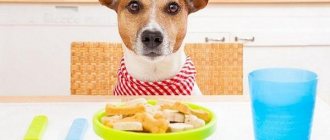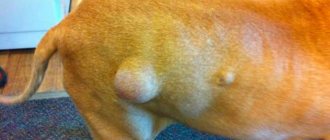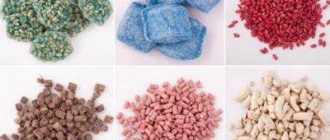It is widely known that the ancestors of dogs were wolves - predators that fed on the meat and bones of their prey. The logical conclusion follows from this: dogs eat bones. This is true, but only partly true for our favorites. Modern dogs are more sensitive, since when breeding the breed, breeders often sacrificed the animals' endurance, preferring external characteristics to health. In this article we will figure out which bones can be given to a dog, and also answer the question - what awaits an animal that eats prohibited chicken bones.
Is it possible or not to give chicken bones to dogs?
The bones of birds differ from the bones of mammals; they are more fragile and lighter, and often hollow. This is due to their lifestyle and ability to fly. Chicken bones are no exception. Chicken bones do not contain any of the nutrients dogs need. Eating them will not bring any benefit or saturation to your pet.
However, offal can be harmful to dogs. In addition to damaging the oral cavity, bones can scratch the mucous membranes of the gastrointestinal tract or even rupture the pet's intestines.
It is especially dangerous to feed boiled chicken by-products, which become soft when exposed to temperature, turning into a solid porridge that clogs the dog’s stomach. Often, such “blockages” can only be removed with the help of a dangerous operation, the anesthesia from which is very harmful to the nervous system. However, not all chicken parts are prohibited.
Other chicken parts
Paws
Among all offal, the most dangerous are the tubular bones from the wings and legs. They cause irreparable damage to the digestive tract at worst and the bite at best.
Many owners claim that their pets love chicken feet. In this case, you should remove the claws and bones from the paw, boil it and give it mixed with porridge - this increases the likelihood of digestion. Experienced dog breeders recommend preparing jellied meat from paws that have no sharp parts. This hearty dish is given to pets during the period of active growth, as natural gelatin is useful for strengthening the joints of dogs.
Necks
Chicken necks do not contain any bones, making them a safe food for dogs. However, they can only be consumed raw; soft boiled chicken necks can cause rectal obstruction.
Heads
Chicken heads are considered the safest food for dogs, since the brain is a very useful organ containing many useful substances. Before serving, it is recommended to rinse them thoroughly, remove the beaks and scald with boiling water or boil. You should not give your dog chicken heads as a main dish; they must be added to porridge or soft food, since the bones inside the skull are easier to digest when combined with a “side dish.”
Meat
There is no need to doubt this - chicken is safe, contains a lot of protein, low fat, does not cause allergies, is tender and soft, which means it is suitable for puppies. The method of preparation does not matter, but, of course, in raw meat vitamins and all other useful substances will be preserved in their natural form. The recommended cooking method is to scald the chicken meat with boiling water, when it cools down, give it to your pet.
Liver and stomachs
Chicken liver contains huge amounts of vitamin A, which is not very good for the health of dogs - large amounts threaten the health of the musculoskeletal system. You should not serve liver more than once a week. In addition, the liver often causes allergies. Chicken gizzards are a healthier product. A small amount of them will have a good effect on the health of your pet’s coat. You can give it a couple of times a week, adding it to cereal or feed.
Consequences of eating bones. First aid
The most harmless result of eating bones can be scratches in the mouth, but more often than not, such a dangerous meal can lead to :
- damage or loss of teeth.
- changes in bite;
- development of caries;
- bone getting stuck in the throat - injury, suffocation;
- trauma to the stomach, intestines;
- vomiting, diarrhea, constipation;
- rupture of the digestive organ;
- peritonitis and blood poisoning.
The result of these risks can be painful death.
What to do if the dog stole and ate a bone?
- Monitor your pet's condition. If you have symptoms such as vomiting or diarrhea with blood, immediately take your dog to a veterinary hospital, urgent surgery is needed.
- Do not induce vomiting or give your pet laxatives! A sharp spasm can move the static bone, which can damage the lining of a dog's digestive organs.
- The maximum that owners can give is 2-3 tablespoons of any vegetable oil (sunflower, flaxseed, olive), which, due to its enveloping effect, can help gently remove bones from the intestines.
Veterinarian Olga Leonidovna Korkh advises using the “church candle method” in this situation. The wax melts in the stomach, forms a lump around the sharp object, perfectly enveloping the dangerous parts, thereby giving the pet time before the doctor arrives and, accordingly, a chance to live.
- You need to take a church wax candle, remove the wick;
- Cut into small “tablets”;
- Feed it to the dog (small breed - a couple of centimeters of wax, large breed - half a candle);
- Give wax three times a day along with regular food;
- At the first appearance of blood, call the veterinarian.
What to do if your dog is constipated
When faced with the above-mentioned symptoms, you need to know in which case you can cope with the disease on your own, and when you cannot do without the help of a specialist.
This will be discussed in the following sections of the article.
What you can do at home: 4 simple tips for constipation
If you have difficulty defecating, the feces become thickened and dry, try to provide independent assistance to your pet, which consists of the following actions:
- Review your diet. If you feed your dog natural food, exclude treats with bones, as well as foods not typical for dogs - chocolate, sausage, etc. Stop feeding meat and offal. Switch your pet to yogurt and vegetable stew. Feed plums, pumpkin, carrots, bran. If your dog eats pellets, soak them and switch to canned food temporarily.
- If your pet's health is satisfactory, give him Vaseline oil or a prebiotic containing the synthetic polysaccharide Lactulose. Apply an infusion of pumpkin seeds. Pour 2 tablespoons of boiling water and leave for 60 minutes. The portion is intended for a medium-sized dog.
- Traditional medicine recommends preparing infusions of flax or oat grains . Pour one tablespoon of seeds into 100 ml of boiling water and leave for 30 minutes. Give it to your dog twice a day before each feeding.
- Dog breeders advise pouring Vaseline oil inside the dog or giving an enema . I tried both. It didn't work the first time. If mineral oil gets into the respiratory tract, the dog will have to be rescued. And the contents of the enema can cause irritation. Or too rough penetration injures the anus, and the dog’s teeth injure your hand. If you have no experience, wait for a veterinarian.
You should not mindlessly give your dog laxatives intended for humans. If the dog’s health is unsatisfactory or there are additional symptoms, do not take risks, take the patient to the clinic or invite a veterinarian to your home.
When do you need veterinary help?
Veterinary help is sought in the following cases:
- the dog has no stool for more than two days;
- defecation is painful, streaks of blood and pieces of undigested food are found in the contents;
- feces have a putrid odor;
- the dog is depressed;
- the stomach is tense, the touch is painful;
- the dog does not eat, it is vomiting;
- the pet has repeated bouts of vomiting;
- heat;
Provide your veterinarian with the following information:
- dog's age;
- lifestyle: apartment, kennel;
- when did stool retention begin, how does it manifest itself;
- diet, number of feedings;
- what the dog consumed in the last day;
- is there vomiting, what does the expelled mass look like;
- how your pet’s behavior changed after signs of stool retention appeared;
- dates of last vaccinations and dewormings;
- presence of spinal injuries;
- if your dog was operated on, when and for what purpose;
- what diseases the pet suffered;
- does the dog have chronic diseases, if so, what medications were used and when;
- Does your pet often have stool retention?
- what remedies did you use to relieve constipation?
After collecting an anamnesis, the veterinarian examines the dog, identifies inflammatory processes in the perineum, near the anus, and the presence of foreign objects in the intestines. Orders laboratory tests or does without them.
Treatment can be surgical or conservative.
In all cases, laxatives and diet therapy are used.
3. Laxative for dogs: 10 drugs that can be given for constipation
The faster constipation can be eliminated, the better for your pet.
To prevent the dog from weakening from hunger and intoxication, fast-acting laxatives are used.
For pets, veterinary and medical drugs are used that are prescribed by a doctor. They are usually divided into the following groups:
- Saline laxatives for one-time emergency relief of acute constipation.
- Preparations based on mineral or vegetable oils.
- Prebiotics, lactulose derivatives. It is a disaccharide consisting of galactose and fructose. Not digestible by animal digestive enzymes and pathogenic microbes. Available for enzymes of beneficial bacteria of the large intestine, which eliminate pathogenic flora and normalize digestion. Prebiotics have a gentle effect.
What can you give instead of chicken bones?
Why give bones to your dog at all? They have no nutritional value and do not satisfy hunger. Many will answer - the dog should chew, it is useful. However, veterinarians argue: a dog is not a rodent, it should not grind down its teeth.
During the period of active growth, when the teeth are constantly itching, the puppy needs to relieve tension from the gums, that is, chewing. But not chicken bones. Sugar seeds from pet stores are perfect for this role.
Bones are also not suitable for “dental cleaning”; on the contrary, they cause plaque, tartar, and even caries. You can brush your dogs' teeth with special brushes, gelatin or silicone toys.
Bones from other animals are also not suitable for all dogs. You can't eat bones:
- small puppies;
- pregnant bitches;
- older animals.
What other animal bones are allowed and not allowed for an adult dog?
Beef and pork bones
The only offal approved by veterinarians. They contain little fat that is harmful to your pet’s figure (from pork, if any, you need to cut it off), they are strong and not sharp. These are the bones that owners give to the dog so that he can chew without the risk of harming himself and his organs.
Only raw bones are allowed. When boiled, a beef bone can clog a dog's gastrointestinal tract, causing constipation.
Lamb and goat bones
They have a high fat content and are poorly accepted by the dog's body, leading to indigestion, vomiting and constipation. Veterinarians do not recommend giving them to your pet even raw.
Rabbit and turkey bones
Absolutely not suitable for dogs. Fragile and sharp, they break, and their fragments inevitably damage the mucous membranes of the animal’s gastrointestinal tract. In addition, turkeys often carry salmonella, which contains both raw and cooked bones.
Fish bones
Fish, in principle, is not suitable for every breed, since some dogs are allergic to phosphorus. Fish bones - killing a dog. In no form are they absorbed by the animal’s body, causing terrible damage to the mucous membranes of the esophagus, which provokes terrible pain. A bone stuck in the throat, most often, cannot be removed without an experienced veterinarian. The pet may die from asphyxia before his arrival.
How to switch to a healthy diet
The body of an animal that eats commercial food cannot immediately adapt to natural food. It takes about 7-10 days to switch your pet to a natural diet. During this time, the acidity level of the stomach will drop to the natural pH level of 2.
Here are some tips for those who want to switch their pet to a healthy diet:
- Transition your pet to a raw food diet gradually. Many cat and dog owners give up on the idea of a raw diet because the animal vomits after eating. From the above it follows that the transition should be gradual, it will take about a week. This period is needed for the acidity of the animal’s stomach to normalize.
- If you plan to feed raw bones (and they are an important part of a healthy diet), include raw meat in your daily diet. Animal protein will keep stomach acidity at the desired level.
- A natural diet will protect your pet from bacterial contamination and food poisoning, and will reduce the risk of obstruction from eating bones. Dogs who eat processed food have significantly higher levels of salmonella bacteria in their feces than dogs who eat raw food.
Remember that cats and dogs have been eating raw meat and bones for 40 thousand years. Eating natural food will not only not harm your pet, but will also make it healthier.
Did you like the article? Tell your friends:
Comments
Briefly about the main thing
- Chicken bones injure the internal organs of dogs, which can cause the death of a pet;
- There are no nutrients in the bones; they will not satisfy your hunger;
- An adult dog should not constantly chew on something;
- A dog can brush its teeth with treats or toys from a pet store;
- Beef and pork bones are included in the permitted list;
- Allowed foods can only be given raw;
- Turkey, rabbit and fish are just as harmful as chicken;
- First aid is the “candle method”: wax “neutralizes” sharp corners;
- If you see blood in your vomit or feces, call your veterinarian.











